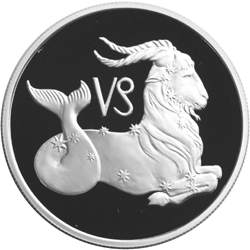Capricorn (astrology) facts for kids
Quick facts for kids Capricorn |
|
|---|---|
| Zodiac symbol | Sea goat |
| Duration (tropical, western) | December 21 – January 20 (2025, UT1) |
| Constellation | Capricornus |
| Zodiac element | Earth |
| Zodiac quality | Cardinal |
| Sign ruler | Saturn |
| Detriment | Moon |
| Exaltation | Mars |
| Fall | Jupiter |
Capricorn (which looks like this: ♑︎) is the tenth sign in the zodiac. The zodiac is like an imaginary belt in the sky that the Sun, Moon, and planets appear to travel through. There are twelve zodiac signs in total.
Capricorn comes from the constellation of Capricornus, which looks like a horned goat. In astrology, Capricorn is seen as an Earth sign, meaning it's connected to things that are stable and practical. It's also one of the four Cardinal signs, which are known for starting new things. The planet Saturn is said to rule Capricorn. This means Saturn's energy is strongly linked to this sign.
If you follow the tropical zodiac, the Sun is in Capricorn from about December 21 to January 21. If you follow the sidereal zodiac, the Sun is in Capricorn from around January 16 to February 16.
Contents
What is a Sea-Goat?
The symbol for Capricorn is often a sea goat. This is a creature with the head and upper body of a goat and the tail of a fish. This idea might come from an ancient Sumerian god named Enki. Enki was a god of wisdom, creation, and water. He was also shown with the upper body of a goat and the lower body of a fish. Later, he was known as Ea in other ancient stories.
Capricorn in India
In Hindu astrology, the sign similar to Capricorn is called Makara, which is often shown as a crocodile or a sea monster.
Cultural Celebrations of Capricorn
In India, the zodiac sign of Capricorn is celebrated with a special festival called Makara Sankranti. This festival is very important!
Why Makara Sankranti is Special
The Indian astronomical calendar is different from the Western calendars we use, like the Gregorian calendar. The Indian calendar is based on the actual movements of the Sun. Because of this, Makara Sankranti is celebrated on either January 14 or 15 each year. This is when, according to the Indian calendar, the Sun truly enters the Capricorn sign. People celebrate this day with joy, kite flying, and special foods.
See also
 In Spanish: Capricornio (astrología) para niños
In Spanish: Capricornio (astrología) para niños



